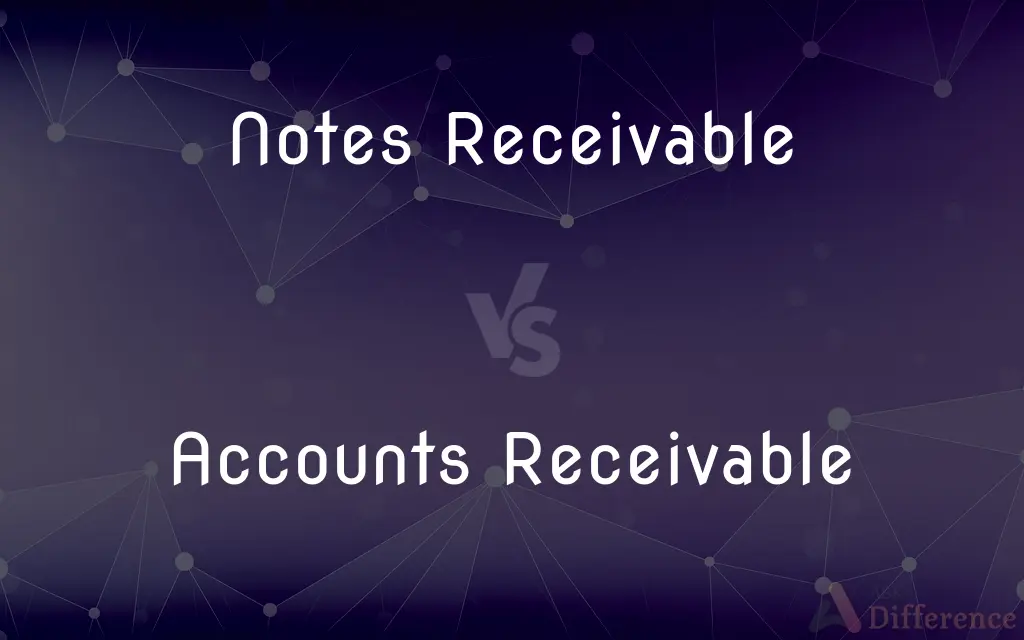Notes Receivable vs. Accounts Receivable — What's the Difference?
By Tayyaba Rehman — Published on October 26, 2023
Notes Receivable refers to written promises for payment at a future date, while Accounts Receivable are amounts owed to a business for goods/services sold on credit.

Difference Between Notes Receivable and Accounts Receivable
Table of Contents
ADVERTISEMENT
Key Differences
Notes Receivable and Accounts Receivable, both pivotal components of a company's financial management, serve as representations of amounts owed to a business. Notes Receivable are written promises wherein the payer agrees to pay a certain amount by a specific date, typically involving interest payments. Accounts Receivable, on the other hand, represents amounts that are owed to a business for goods or services provided on credit, without a formal written promise or interest accrual, and are typically expected to be received in a shorter period.
Notes Receivable generally involve a written agreement that clearly stipulates the repayment terms, including the principal amount, interest rate, and maturity date. Conversely, Accounts Receivable is somewhat informal, lacking detailed documentation or stringent terms of repayment. While Notes Receivable define a clear payment schedule and interest payments, Accounts Receivable is often devoid of such distinct and formalized repayment schedules, with payment expected generally within 30 to 90 days.
The accounting treatment for Notes Receivable and Accounts Receivable is somewhat different, primarily because of the involvement of interest in the former. Notes Receivable necessitates accounting for interest income, which accrues over the period until maturity. Accounts Receivable, being typically non-interest bearing, does not require the tracking and accounting for interest income, focusing primarily on the principal amount to be received.
In terms of risk and assurance, Notes Receivable often stands to be a bit more secure compared to Accounts Receivable. The formality and legality embedded in Notes Receivable through written agreements and interest impositions render a layer of assurance and reduced risk of default for the lender. Accounts Receivable, given their informal nature and lack of interest impositions, might pose a slightly higher risk of default or late payment, as there are generally fewer repercussions for the customer in doing so.
Considering collection efforts and legal implications, Notes Receivable offers a clear pathway due to the specific terms and conditions documented. In the event of non-payment, legal proceedings may be more straightforward with Notes Receivable due to the explicit acknowledgment of the debt by the payer. On the flip side, Accounts Receivable, without written agreements, may face comparatively complex and intricate paths in legal pursuits aimed at debt recovery, necessitating the establishment of proof for the provided goods or services and the agreed-upon price.
ADVERTISEMENT
Comparison Chart
Documentation
Formal, with written agreement
Typically informal, without written promise
Interest Accrual
Usually involves interest
Generally does not involve interest
Payment Term
Explicitly defined with a maturity date
Often undefined, expected within 30-90 days
Risk Level
Relatively lower risk due to formal documentation
Slightly higher risk due to informal setup
Legal Pursuit Facilitation
Easier due to clear terms
Potentially complex due to lack of documentation
Compare with Definitions
Notes Receivable
Legally binding promise to pay specific amounts.
The agreement entailed a notes receivable, ensuring future payment.
Accounts Receivable
Claims on customers for credit transactions.
The company’s accounts receivable were significantly aging.
Notes Receivable
Receivable documented with repayment and interest terms.
The notes receivable from the client specified a 5% interest rate.
Accounts Receivable
Outstanding amounts from customer credit purchases.
The business offered discounts to promptly clear accounts receivable.
Notes Receivable
An asset documenting pledged payment with maturity.
The firm’s assets included notes receivable aggregating to $50,000.
Accounts Receivable
Ledger entry showing pending customer payments.
High accounts receivable indicated potential liquidity issues.
Notes Receivable
A claim supported by a payer’s written promise.
The ledger reflected notes receivable maturing next quarter.
Accounts Receivable
Amounts owed for credit sales of goods/services.
The monthly report showed increasing accounts receivable.
Notes Receivable
Formal written promise for payment.
The company recorded the client’s notes receivable due in six months.
Accounts Receivable
Asset reflecting amounts to be received soon.
Management was focused on converting accounts receivable to cash.
Common Curiosities
What are accounts receivable?
Accounts receivable represent amounts owed to a business for goods or services provided on credit.
Do accounts receivable include interest?
Typically, accounts receivable do not involve interest and are due within a short-term period.
How is notes receivable documented?
Notes receivable is formally documented with specific repayment and interest terms and a maturity date.
What is notes receivable?
Notes receivable is a written promise by a customer to pay a specific amount by a certain date, often with interest.
Is interest involved in notes receivable?
Yes, notes receivable often include an interest rate, to be paid along with the principal amount.
Share Your Discovery

Previous Comparison
Cream of Tartar vs. Tartaric Acid
Next Comparison
Jackie vs. JackyAuthor Spotlight
Written by
Tayyaba RehmanTayyaba Rehman is a distinguished writer, currently serving as a primary contributor to askdifference.com. As a researcher in semantics and etymology, Tayyaba's passion for the complexity of languages and their distinctions has found a perfect home on the platform. Tayyaba delves into the intricacies of language, distinguishing between commonly confused words and phrases, thereby providing clarity for readers worldwide.













































